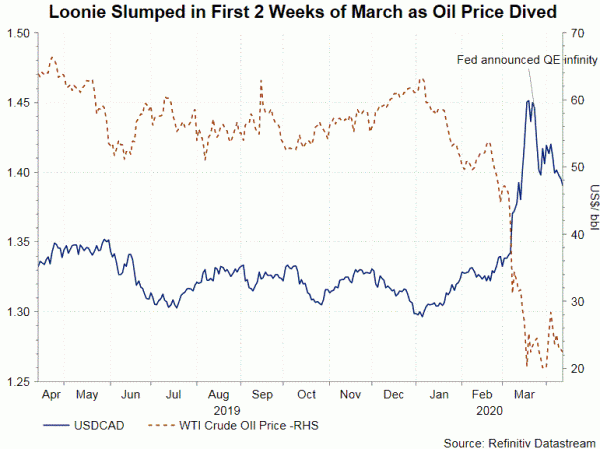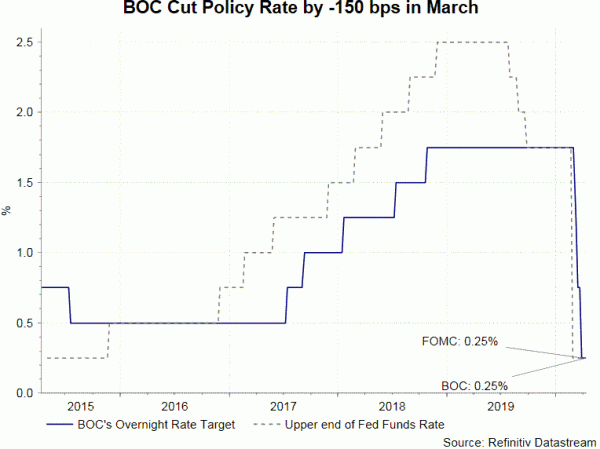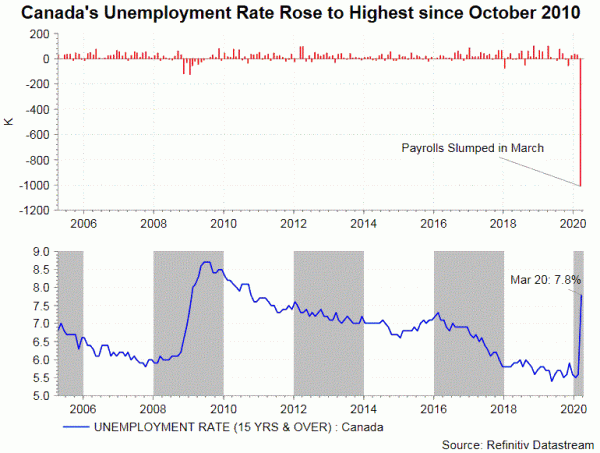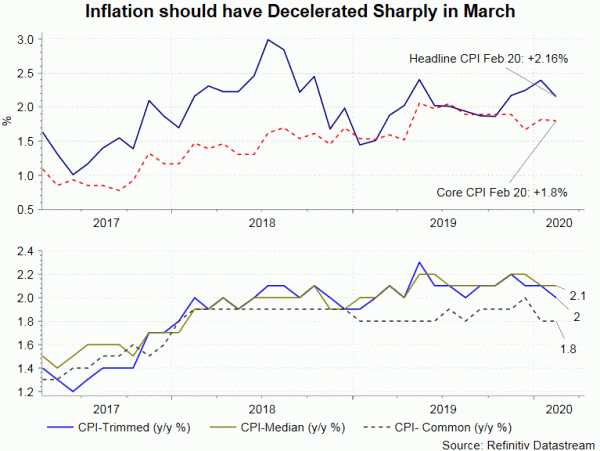Having cut the policy three times and announced QE program in March, BOC will likely keep the powder at the April meeting. Policymakers will explain the rationale of the stimulus measures, reinforcing that the policies are essential to containing the sharp slowdown in the first quarter. Recent economic data suggest that Canada’s economy is hit hard by the coronavirus pandemic and the collapse of oil prices. The members will likely continue to warn of the negative impacts brought about the coronavirus and selloff in oil prices due to global surplus. There will likely sharp downgrade in economic projections. We expect more easing measures to be announced in the near future, probably at unscheduled meetings.
BOC has cut its overnight lending rate, by -50 bps, to 1.25% at the March meeting. This was shortly after Fed’s first emergency rate cut. The central bank then adopted two emergency cuts, each by -50 bps on March 13 and March 27. The policy rate now stands at 0.25%. Besides, the central bank joined the QE camp on March 30, pledging to purchase a minimum of CAD5B per week in government securities and short-term debt issued by companies. Earlier last month, the central bank already announced to buy Canada Mortgage Bonds in the secondary market, targeting purchases of up to CAD 500M per week, for as long as market conditions warrant, and Bankers’ Acceptance securities. Other measures announced by BOC include a new standing term liquidity facility to struggling institutions, and reduction of capital adequacy buffers for banks.
The country’s PMI slumped to 26 in March, much weaker than consensus of 41 and 54.1 in February. Manufacturing PMI by Markit fell to 46.1 in March from 51.8 a month ago. Both reports suggested economic contraction in March. The job market was disastrous. The number of payrolls slumped -1.01M in March, compared with consensus of a -350K decline. In February, payrolls added +30.3K. The unemployment rate increased sharply to 7.8%, from 5.6% in February. The increase was significant despite a fall in the participation rate. On inflation, headline CPI eased in February, but stayed above BOC’s +2% target. BOC’s inflation gauges also averaged at about +2%. The March reading will be released on April 22. It is likely that the headline reading slipped below +2%. The loonie slumped in the first two weeks of March, mainly due to the collapse of oil price after OPEC+ stalemate. Although oil prices stabilized last week as OPEC+ and the US reached a deal to cut output by +10M bpd, the effective cut is insufficient to offset the significant decline in global demand. Recovery in loonie was, however, a result of Fed’s announcement of QE infinity. It is likely the BOC will accelerate QE in April to contain detriment brought about by the oil market and to contain strength in Canadian dollar.
 If the central bank is to implement additional measures, we expect it would be on the “unconventional” front, given the limited room for more rate cuts. It is possible for the central bank to offer more helps to individual provinces by buying provincial debts as provincial spreads over Canada’s remain materially wider since February 20. Besides, BOC might broaden the asset classes in its buying program and/ or introduce yield curve targeting like RBA.
If the central bank is to implement additional measures, we expect it would be on the “unconventional” front, given the limited room for more rate cuts. It is possible for the central bank to offer more helps to individual provinces by buying provincial debts as provincial spreads over Canada’s remain materially wider since February 20. Besides, BOC might broaden the asset classes in its buying program and/ or introduce yield curve targeting like RBA.

















